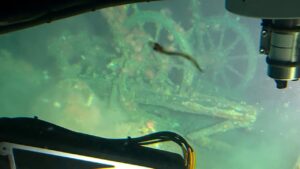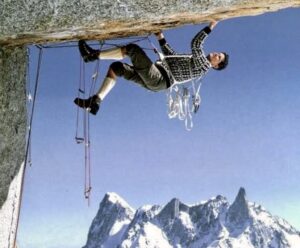“The decision to not carry a drill or any fixing rope is a very significant philosophical statement. It greatly increases the difficulty, significantly reduces the certainty of success and makes the ascent far more complex and committing.”
Leo Houlding needs no introduction. One of Britain’s top adventurers, the 37-year old alpinist first exploded onto the climbing scene in his teens with ascents of trad climbing routes that had other climbers scratching their heads. As a prodigy of the sport, he is known for both the difficulty of the routes he pioneers and his eclectic approach to the world of exploration. The UK’s best-known mountaineer Sir Chris Bonington calls him “bold and innovative,” admiring the way he relates to other people and his humility as he pushes the limits of what is possible.
At this very moment, Leo is in Antarctica about to embark on his Spectre Expedition, a three-man journey to the Gothic mountains range alongside the Ross Ice Shelf, comprising Leo, Mark Sedon and Jean Burgun. The prize is the unclimbed south face of the Spectre, the most dramatic spire in the Transantarctic Mountains.
The Spectre Expedition draws heavily on the alpine approach to mountaineering, which centers on a light and fast approach based on the strength and skill of the climber as opposed to the brute-force style of expedition mountaineering. Because of this, Leo envisages it as a “new-school expedition,” whereas Sir Chris Bonington is more blunt in his description: “Make no mistake, it is a hell of a thing they are undertaking.”
Despite the inevitable chaos and pressures in the lead up to departure, Leo was kind enough to spare a moment to answer our questions on his ground-breaking expedition.
—
ExWeb: The Spectre site notes that “Today’s communications, technology & infrastructure have radically transformed Antarctic exploration opening the door to a new age of discovery.” Specifically, how do you think modern tech has changed polar exploration and what it means to be a polar explorer?
Leo Houlding: It’s changed everything. To start with it’s a very different kind of ‘exploration’ if you can call it that? Google Earth let’s us see and measure everywhere. The Iridium constellation lets us talk to everyone, everywhere, all the time including rescue services. Inreach constantly tracks us live and lets us follow other expeditions out there from in the field, as well as get weather, GPS navigation, two-way messaging and call for SOS rescue, making it my favourite expedition tech device.
Then there’s the knowledge and infrastructure of operations like ALE which is progressing every year. The GIS data mapping software they have for Antartica is incredible – some satellite surveys are in such detail to show crevasses 10m wide beneath the snow. It’s incredible!
Then there’s the kit like clothing, tents, pulks, kites etc. On top of this, the experience and knowledge that have been built up by extremely experienced polar guides and experts is shared and can be learned more easily than ever before.
ExWeb: On your ascent of Spectre, you have stated that “all climbs will be made in Alpine style. No fixing rope; no drill & no bolts will be carried.” To play devil’s advocate, is this not simply an aesthetic decision? A first ascent is a first ascent, whatever the means used. Could you explain your reasoning here?
Leo: We would like to approach the Spectre in the purest style we can. Our strategy is not whiter than white. We will be flying to our drop off, we will very likely be using aid on the climb, it will most likely take multiple days. However, to those that understand something about climbing style and ethics, the decision to not carry a drill or any fixing rope is a very significant philosophical statement. It greatly increases the difficulty, significantly reduces the certainty of success and makes the ascent far more complex and committing. If you don’t understand the nuances and subtleties of climbing style this must sound crazy. In essence it is about adventure and exploration. We do not wish to undertake such a big and complex expedition only to then make it easier for ourselves.
ExWeb: Given the complex nature and of this expedition, it is highly likely that some parts will be successful while others may fall short. Could you state for the record what you would consider success and what you would consider failure?
Leo: Success will be a safe trip where we climb something and that we complete without having to get picked up by aircraft from anywhere other than Hercules Inlet. Our primary objective is the south spur of the Spectre, a very proud line. A bonus would be touching each ice shelf and a trans-continental traverse.
Failure would be any sort of serious injury or having to get picked up from miles away from where we plan.
ExWeb: This expedition has been four years in the planning and comes at a price tag of £290,000. Could you outline the planning process?
Leo: A trip as expensive and complex as this really does require a vast amount of planning and preparation. I’ve been on five separate trips to the Hardangervidda in Norway. Fun missions in their own right, but also training for this. I did a 1000-mile kite trip in Greenland last year and have been on two month-long climbing trips to the bugaboos in BC, again great undertakings in their own right but also training for this mission. There have also been literally thousands of hours of scheming, consultation and geeking out on every item of kit and every detail. There are no correct answers but there are incorrect ones! We hope to be reasonably right over perfectly wrong!
ExWeb: What equipment have Berghaus developed for you that is particularly exciting?
Berghaus have been fantastic with their support for our vision. Their product innovation team came to Norway for a week with us last year and we took them out in the wilderness in full-on winter conditions for a night to get a taste of what we could expect.
The new Ramche, Trans-Antartica Big Bown jacket we have developed has the highest warmth to weight ration of any jacket in its class. We also have an amazing new breathable down mid-layer – twice as warm and half as heavy as Polartec 300 fleece. Then my favourite piece – the Leotard – a one-piece micro fleece mid layer, makes you look pretty special but so toasty warm and comfortable. Sadly, I’m not sure that one’s going to make it to market.
ExWeb: The expedition is segmented into separate stages including kiting, climbing, man-hauling and kiting again. The 400 km man-haul against the Katabatic wind would probably be a low point for us. What are you most and least looking forward to?
Leo: Without question the man hauling is the part I’m least excited about. Doesn’t do it for me or the other guys at all. We are hoping to be able to upwind kite or get lucky with an atypical northerly wind for that section, but we have to be prepared to walk if needs be.
I’m most looking forward to the climbing. At 86*S its certainly the most southerly rock climbing in the world and I’m worried to could be too cold. But it is such an aesthetic line and the right looks amazing. Can’t wait to get stuck in!
I’m also pretty psyched about the kite approach and some mazing through the mountainous terrain of the Scott Glacier. It will be great to find out if we can actually upwind kite with heavy loads on a bumpy surface and crevasses terrain, too.
ExWeb: Talk to us about risk management and commitment; at what point(s) are you truly committed and unable to evacuate if an emergency occurs? What are your biggest concerns in this respect?
Leo: I have spent ages working with ALE to limit the risk as much as possible and develop and very compressive communication and evacuation plan as well as safe route. They are so professional and so good at what they do. Antarctic logistics mean there will be very little time when we are truly committed. We have identified loads of landing sites along our route from where we can be extracted if necessary, including close to the base of the Spectre. We are a long way from any logistics hubs, which makes things a bit more spicy, but the only totally committed time will be on the wall. Then we’re on our own. But I’m not too worried about that as that’s my true field of expertise. During bad weather we’re pretty committed and there’s a couple of sections of heavy crevassing and big sasstrugi where a medivac would be complex, but on the whole it’s a pretty safe route and with ALE’s support, I’m not overly concerned about the Level of risk.
—
ExplorersWeb will be following Leo Houlding throughout the Spectre Expedition.
The Spectre Expedition starts at 88°S, 110°W, the furthest point ALE can fly from base camp at Union Glacier. There they will harness the katabatic winds to kite-skiing from the drop off down to the Gothics range which contains their main objective, the 2,020m-high Spectre. After 20 days’ climbing, they continue down to the edge of the Ross Ice Shelf, then return to the drop off — a grueling hike against the prevailing wind. They will finally turn north, pick up the winds and to kite to Union Glacier.
Spectre: Transantarctic Expedition
Confronting Fear – Leo Houlding – Spectre Expedition
Leo Houlding’s Spectre: “The Most Remote Mountain on Earth”
Antarctica 2017 Weekly Roundup 11/19






